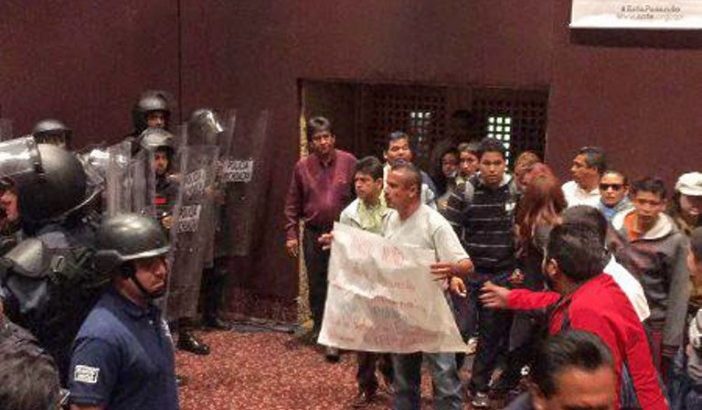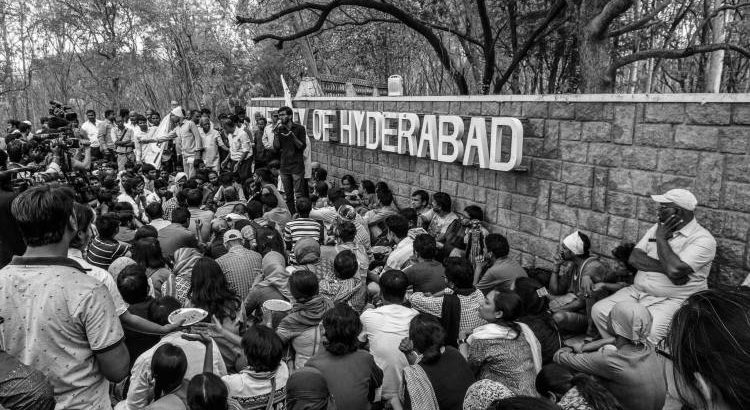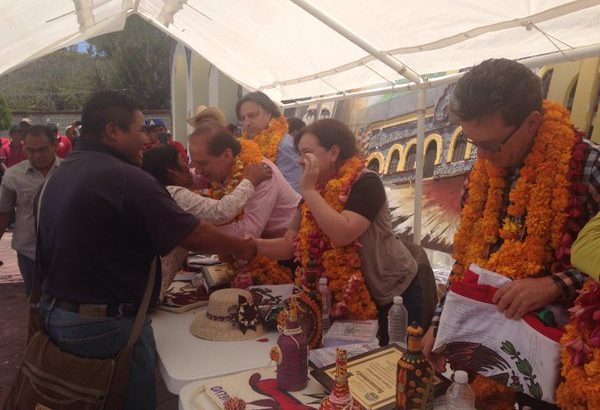Fuente: ctxt España/ 27 de Abril de 2016
ÁLVARO GUZMÁN BASTIDA / TRADUCCIÓN: ADRIANA M. ANDRADE
Nancy Fraser (Baltimore, 1947) milita al frente de la lucha feminista y la teoría crítica desde finales de los años 60. Crítica de lo que ella denomina “feminismo neoliberal”, sus teorías sobre el reconocimiento y redistribución como términos para entender las desigualdades sociales son muy influyentes. Fraser recibe a CTXT en su oficina del departamento de filosofía de la New School for Social Research, en el East Village de Manhattan, para hablar de la preeminencia de las políticas de identidad, la importancia de Bernie Sanders, Donald Trump y Hillary Clinton, y las razones por las cuales sintió la necesidad de introducir un tercer concepto — el de ‘representación’ en su último libro Fortunas del feminismo(Traficantes de sueños, 2012) para explicar los males de la sociedad contemporánea y dónde debería centrarse la lucha para arreglarlo.
Hace veinticinco años escribió sobre el término “reconocimiento”, que tomó prestado de Hegel, explicando que fue la palabra clave de aquella época a la hora de entender cuestiones de diferencia e identidad. ¿Cómo lo entendía Hegel y por qué es importante para entender el presente?
En Hegel tenemos, esencialmente, dos actores que se encuentran y que son sujetos; pero para ser un sujeto completo, cada uno de ellos debe ser reconocido por el otro. Cada uno reafirma al otro como sujeto en su propio derecho, que es a la vez igual y diferente de mí mismo. Si los dos pueden afirmar eso, entonces hay un proceso de reconocimiento recíproco, igualitario y simétrico. Pero, como es sabido, en la dialéctica amo-esclavo se encuentran el uno al otro en términos desiguales y asimétricos, en términos de dominación y subordinación. Entonces hay un reconocimiento no recíproco.
¿Por qué está tan en boga desde el principio de los años 2000?
Tiene que ver con lo que en ese momento llamé la condición postsocialista. Fue el momento de la historia de las sociedades de posguerra en el cual la problemática de la justicia distributiva había perdido la capacidad hegemónica de articular la lucha y el conflicto social de las mayorías. Hasta ese momento, durante la posguerra, el paradigma de la redistribución había sido hegemónico, y casi todo el discurso social y el conflicto se organizaban en esos términos. Esto significaba que era difícil que muchos problemas salieran a la superficie. Muchas reivindicaciones fueron relegadas a los márgenes porque no encajaban con la gramática distributiva. Básicamente, lo que vemos ahora al mirar atrás es que las políticas del reconocimiento coinciden con el auge del neoliberalismo. El neoliberalismo está, de hecho, desplazando el imaginario socialdemócrata y su ataque contra la justicia distributiva igualitaria está destruyendo el modelo socialdemócrata; si no completamente, al menos se está deteriorando y perdiendo su influencia, su habilidad para organizar el espacio político y el discurso; y de alguna manera esto abre un espacio a las diversas reivindicaciones y luchas del reconocimiento.
¿Se le ocurre algún ejemplo de esto?
Después de 1989*, tras el colapso del comunismo y el bloque soviético. ¿Qué pasó? Muy rápidamente hubo un aumento del antagonismo religioso, del antagonismo nacionalista – y ahí entramos en el terreno del reconocimiento. Antes, esas reivindicaciones se reprimían –se excluían. Por tanto, existía una versión comunista del discurso distributivo, que quedó destruida. En Occidente, supone la derrota de la hegemonía socialdemócrata. Aparte del ascenso del neoliberalismo, parte de esto tiene que ver con los nuevos movimientos sociales que estallan en los años sesenta. La Nueva Izquierda tenía un ethos radical, o mejor dicho anticapitalista; ponía énfasis en la redistribución y el reconocimiento de manera muy radical. Pero cuando el tiempo pasó y el espíritu radical anticapitalista de la nueva izquierda empezó a desvanecerse, los movimientos sucesivos –un nuevo tipo de feminismo, un nuevo anti racismo, las políticas sexuales del movimiento LGTB– tendieron a ignorar la visión política económica y a centrarse en las cuestiones que yo definiría en términos de status o reconocimiento.
Usted conecta estas cuestiones con las políticas de identidad. ¿Hasta qué punto es un término peyorativo?
Una parte de lo que intento hacer en mi análisis es evitar una identificación rápida entre las políticas de identidad y las de reconocimiento. Lo que he tratado de explicar es que las políticas de reconocimiento son una dimensión legítima de la justicia, y que las reivindicaciones para superar las injusticias del reconocimiento son importantes; y que simplemente no se pueden reducir a reivindicaciones de redistribución como lo haría el marxismo común, de brocha gorda. Quería defender la importancia, la legitimidad, la autonomía relativa de las reivindicaciones del reconocimiento. Intento sugerir que hay más de una manera de entenderlas – que no tienen por qué adoptar la forma de políticas de identidad. Es cierto que, con frecuencia, las reivindicaciones de reconocimiento adquieren formas de políticas de identidad. Y esto, desde mi punto de vista, es desafortunado. Crea todo tipo de problemas, y normalmente es mejor si se puede encontrar una visión no identitaria de lo que significa la lucha por el reconocimiento.
¿Y qué debería significar?
Un movimiento como el feminismo no debería luchar por la idea de que hay una identidad o ethos feminista diferente, que requiere de un reconocimiento afirmativo para equipararse con la masculinidad. No; diría que las políticas del reconocimiento en un movimiento feminista deberían ser las luchas contra las formas del estatus de desigualdad ligadas a los términos de género. Y eso deja muy abierta la posibilidad de revalorizar “lo femenino”, sea lo que fuere. Por eso intento desligar las políticas de reconocimiento de las políticas de identidad.
Mirando atrás, me da la sensación –corríjame si es un análisis equivocado- de que en Estados Unidos ha habido un gran avance en términos de reconocimiento, como el matrimonio homosexual, e incluso en temas de visibilidad, como tener un presidente negro. ¿Ha habido demasiado de eso y muy poco énfasis en la redistribución? Sigue habiendo mucha desigualdad, y no parece que esté mejorando…
No es una cuestión de demasiado o muy poco, sino de que no ha habido un equilibrio. Ha habido un desequilibrio y mucha parcialidad. Por ejemplo, el movimiento homosexual y el movimiento LGTB se centran en la igualdad en el matrimonio y en el acceso al servicio militar. No me parecen las mejores opciones para enfocar la lucha. En cualquier caso, las dos tienen, y eso es interesante, un elemento distributivo. El Ejército es una de las pocas vías que tienen los trabajadores para pagar las matrículas universitarias, por ejemplo, o sea que genera beneficios económicos. Y tener el derecho a casarse conlleva derechos económicos y sociales, además de los simbólicos, de reconocimiento…
¿Cuáles habrían sido las rutas alternativas?
Hubiera preferido luchar para conseguir que los derechos sociales básicos fueran simplemente derechos individuales, independientemente del estado civil; hubiera preferido una sociedad que no enfatizara el hecho de estar o no casado. En vez de decir “¡nosotros también queremos casarnos!”, ¿por qué no decir, “te damos derechos sanitarios, fiscales y todos los demás beneficios por ser simplemente una persona, un ciudadano, un residente en el país?”.
Entiendo que se refiere a que esos derechos están en pie de igualdad en términos de redistribución, pero ponen el acento en el estatus. ¿Es por eso por los que los prefiere?
Sí. Porque la cuestión igualdad en el matrimonio introduce odiosas comparaciones de estatus entre los que están casados y los que no. No debiéramos reforzar eso…
A principio de los años 2000 escribió sobre el problema del “desplazamiento”, en el cual “las cuestiones de reconocimiento se usan para marginalizar y ‘exclusivizar’ las luchas redistributivas”. Han pasado ya casi dos décadas. ¿Qué balance hace de este periodo?
El paisaje del conflicto social y de las reivindicaciones, al menos en Estados Unidos, es muy diferente de cuando escribí aquello. El ejemplo más espectacular es la campaña electoral de las primarias presidenciales, donde por un lado está Bernie Sanders, que se presenta como un “socialista democrático”, y está lanzando un discurso de clase abrumadoramente centrado en la desigualdad. También apoya todas las buenas causas progresistas de reconocimiento, pero el verdadero centro de gravedad lo pone en la cuestión de la clase billonaria, el uno por ciento y todo eso…
¿Le sorprende que Sanders haya llegado tan lejos en las primarias enfatizando su discurso sobre las clases sociales?
Si. Es una sorpresa fantástica. Estoy muy contenta; nunca lo hubiera pensado, y demuestra lo lejos que hemos llegado desde el final de la Guerra Fría. El hecho de que puedas usar el término socialismo y que eso ya no implique o inspire la locura y la estigmatizacion de los ‘rojos’ que imperaba entonces es muy interesante. En el otro lado, está Donald Trump, que presenta un cierto tipo de populismo autoritario, nacionalista de derechas que evoca también una problemática de clase pero la colorea de una manera excluyente, cuasi racista, y ciertamente nacionalista. Es como si estas dos figuras difirieran considerablemente sobre las políticas de reconocimiento –así como en sus propuestas programáticas– pero los dos expresan la relevancia de la distribución. Esto es nuevo. Cuando escribía a mediados de los noventa la distribución estaba en los márgenes, y todo era reconocimiento, reconocimiento, reconocimiento. Esto ya no es así. El reconocimiento no desaparece, y no debería hacerlo, pero creo que ahora estamos ante un equilibrio muy diferente.
Ya que ha hablado de las elecciones, ¿qué hay de la otra candidata demócrata, Hillary Clinton? Varias feministas de la ‘segunda ola’ como Gloria Steinem han declarado que las mujeres deben votarla porque es una mujer y la candidata feminista. ¿Lo es?
Yo no diría que es la candidata feminista. Pero está pasando algo muy interesante. Clinton lleva décadas presumiendo de ser una feminista de carné. Empezó su carrera abogando por las mujeres y los niños; es famosa por su discurso en el que equiparaba los derechos de las mujeres y los derechos humanos ante la ONU; y ha defendido con consistencia el derecho al aborto. Entonces, si eso encaja con la parte del reconocimiento, ella ha estado en eso de una manera más explícita y central que Sanders. Pero, por otro lado, ¿qué tipo de feminismo es ese? Clinton representa un tipo de feminismo neoliberal centrado en romper el techo de cristal. Eso significa eliminar los obstáculos que impiden a mujeres más bien privilegiadas, con buena formación, y que ya poseen grandes cantidades de capital cultural y de otro tipo, subir en los escalafones de gobiernos y empresas. Las principales beneficiarias de este feminismo son mayoritariamente mujeres privilegiadas, cuya posibilidad de ascender depende en buena medida del enorme grupo que se encarga del servicio doméstico y el cuidado familiar, también muy feminizado, además de muy mal pagado, muy precario y racializado. Y a la vez, Hillary Clinton, como su marido, está muy implicada con Wall Street, con la desregulación financiera y la neoliberalización de la economía. Así que el tipo de feminismo que Sanders representa tiene más posibilidades de ser un feminismo para todas las mujeres, para las mujeres pobres, para las mujeres negras, para las mujeres de la clase obrera… Y esto se acerca más a mi tipo de feminismo.
En su libro Fortunas del feminismo introduce un tercer término; ya no solo habla de reconocimiento y redistribución sino también de representación. ¿Por qué sintió esa necesidad?
Porque conceptualiza, de una manera explícita, la idea de que más allá de las cuestiones de la distribución, estatus y reconocimiento, hay una serie de cuestiones que tienen que ver con lo político como dimensión fundamental de la sociedad. Creo que en este momento la cuestión de quién tiene standing político en un mundo de refugiados, solicitantes de asilo, inmigrantes sin papeles se convierte en una cuestión muy importante. Esto no es específico del reconocimiento o la redistribución, aunque esté interrelacionado. También tiene que ver con tener voz política.
¿Hasta qué punto trascienden fronteras esas ideas?
Cuando pensamos sobre la voz política, sobre quién la tiene y quién no, creo que deberíamos pensar en una comunidad política acotada a un determinado estado- nación, como Estados Unidos u otros, pero también en un contexto más amplio, internacional, transnacional y global. Vivimos en un mundo en el que los estados están empoderados muy desigualmente. Imagina que eres un ciudadano de Somalia, y que tienes, si no un estado fallido, un estado muy frágil sometido al yugo de los poderes y las instituciones financieras globales, como el FMI –hay cuestiones sobre la voz política que tienen que ver con un nivel más alto, no solo en tu propio estado sino en el sistema mundial. Creo que la única manera de atacar eso es a través del concepto de representación. Ahora habría que pensar en las tres dimensiones de la justicia — o tres formas diferentes de injusticia, si prefieres: una pobre redistribución, el des-reconocimiento y la mala o inexistente representación. No hacerlo supone afrontar los problemas políticos desde el marco equivocado.
¿Y cómo se articula esto en términos de movimientos sociales o políticos? Estoy pensando en Europa, por ejemplo, dónde hay un debate sobre cómo articular las subjetividades políticas, sobre si esto puede pasar sin que las políticas de identidad se afiancen, o incluso se impongan. Usted introduce el concepto de representación o transnacionalización. ¿Se puede construir poder político en un mundo globalizado sin enfatizar la identidad y poniendo de relieve, por ejemplo, la representación? ¿Cómo cree que se podría hacer?
Creo que de alguna manera la estructura y el problema de la Unión Europea es en parte una cuestión de representación. Me refiero al hecho de que el Banco Central Europeo y las instituciones financieras globales, en conexión con lo que comúnmente se llama Troika, tienen en sus manos una gran cantidad de poder, tanto que tienen la capacidad, a través de la imposición de medidas de austeridad, de invalidar elecciones. Pueden decirle a los griegos: “¡No nos importa a quién votasteis, no podéis poner en marcha esas políticas!”. Hay cuestiones básicas sobre dónde reside el poder y la voz política en la Unión Europea, ya que interactúa con el orden financiero global. Todo esto está por encima, o al menos se cruza con problemas de reconocimiento y redistribución. Hay un tipo de problema de reconocimiento en Europa dónde los países ricos del norte miran por encima del hombro a los llamados PIGS — los países del sur– por ser vagos y evasores de impuestos. Esta es una vieja historia familiar de reconocimiento. Pero se convierte en letal cuando interactúa con el problema estructural –que por supuesto tiene que ver con la misma creación del euro– en el que se impone la austeridad sobre la voz democrática.
——————-
English version
1.En la entrevista original Fraser dice «leaning in», en referencia al libro Lean In (Vayamos Adelante: Las Mujeres, el Trabajo y la Voluntad de Liderar) de Sheryl Sandberg, directora operativa de Facebook y Nell Scovell, escritora y directora de televisión.
*En la primera versión, se decía 1999. La fecha correcta es 1989.
Enlace original: http://ctxt.es/es/20160420/Politica/5507/Nancy-Fraser-feminismo-Hillary-Clinton-Bernie-Sanders-reconocimiento-Hegel-redistribucion-representacion-Estados-Unidos-Entrevistas-Elecciones-en-Estados-Unidos.htm#.Vxz3_3f1a9Q.facebook











 Users Today : 38
Users Today : 38 Total Users : 35459944
Total Users : 35459944 Views Today : 44
Views Today : 44 Total views : 3418509
Total views : 3418509